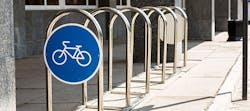On a scale of 1 to 10, how welcoming are your parking options for bicyclists?
If you’re not a cycling enthusiast, you may not think twice about the type, location, or security of your bike racks. But riders will be alienated if it’s clear that no thought or effort was put into bike parking, leaving your racks empty and neglected. Use these five tips to turn your facility into a bike-friendly destination.
1) Find Your Biking Champions
Invite your company’s bicyclists to a brainstorming session and ask them about their riding habits. Look for any barriers that make them hesitant to bring their bikes to work. If you try to implement features without their support, you could end up wasting money on equipment that will go unused because it doesn’t meet their needs, notes Brad Spillman, Senior Facilities Manager with ACT.
ACT Passes the Test for Bike Accommodations
2) Investigate Rack Options
Just as you wouldn’t be cavalier about paving your parking lot, give due consideration to which styles of bike storage will be the most effective.
“Bicyclists hate old-style ‘wheel bender’ racks, the ones where you wedge the wheel between the bars and can’t use a U-lock,” explains Bri Whitcraft, Director of Marketing with Dero, a supplier of bike parking solutions. “They may be common, but they damage bikes and make it easy for thieves to steal everything except the front wheel.”
Choose racks that allow bikes to be locked at both the wheel and frame, recommends Amelia Neptune, Manager for the Bicycle Friendly Business & University program with the American League of Bicyclists. They should also be constructed of materials that won’t easily corrode or dent and include a secure anchor that can support the weight of the bikes, withstand heavy winds, and foil vandalism, she adds.
3) Consider Lockers and Bike Rooms
Open racks should only be used for temporary parking (less than two hours) – think a public library, eatery, or retail store. If you want your employees to commute to work, however, their bikes shouldn’t be exposed for eight hours.
Lockers are a simple crate structure that secures bikes and can be located within your building or outside, explains Richard Hartger, Founder and President of the manufacturer CycleSafe. While they carry a higher upfront cost, they minimize thefts and have the added benefit of keeping bikes shaded and dry.
“Bike rooms are also becoming popular in parking garages or underutilized facility spaces,” notes Susan Hartger, Vice President for CycleSafe. “These can include vertical bike parking or high density racks for space efficiency.”
4) Select the Right Location
Parking convenience is just as essential for bicyclists as it is for those who drive, says Neptune. Install racks or lockers near your building’s main entrance or the one used by employees. You can also convert a parking spot – one stall can usually fit 10-12 bikes.
“If the bike racks are difficult to use or hard to get to, it will deter people,” stresses Siri Preston, Sales Representative with Dero. “Finding usable space may mean having multiple locations for your bike racks rather than a centralized hub.”
For campus settings, consider putting in bike lanes on the streets, recommends Sandy Stewart, Wellness Manager for ACT. This signals to cyclists that your property welcomes bikes and prioritizes their safety by keeping motorists separate.
5) Collaborate with Your HR Ally
Because wellness amenities have a direct impact on employee retention, recruiting, insurance premiums, and absenteeism, seek out a colleague in the HR department. Two heads are better than one when trying to deliver the best biking environment for workers.
“You can’t just have great parking,” Neptune emphasizes. “You can have racks physically in place but that’s not enough to encourage people. You need to offer classes, group events, and incentives to sustain a bike-friendly workplace.”
Jennie Morton [email protected] is senior editor of BUILDINGS.
About the Author
Jennie Morton
A former BUILDINGS editor, Jennie Morton is a freelance writer specializing in commercial architecture, IoT and proptech.
